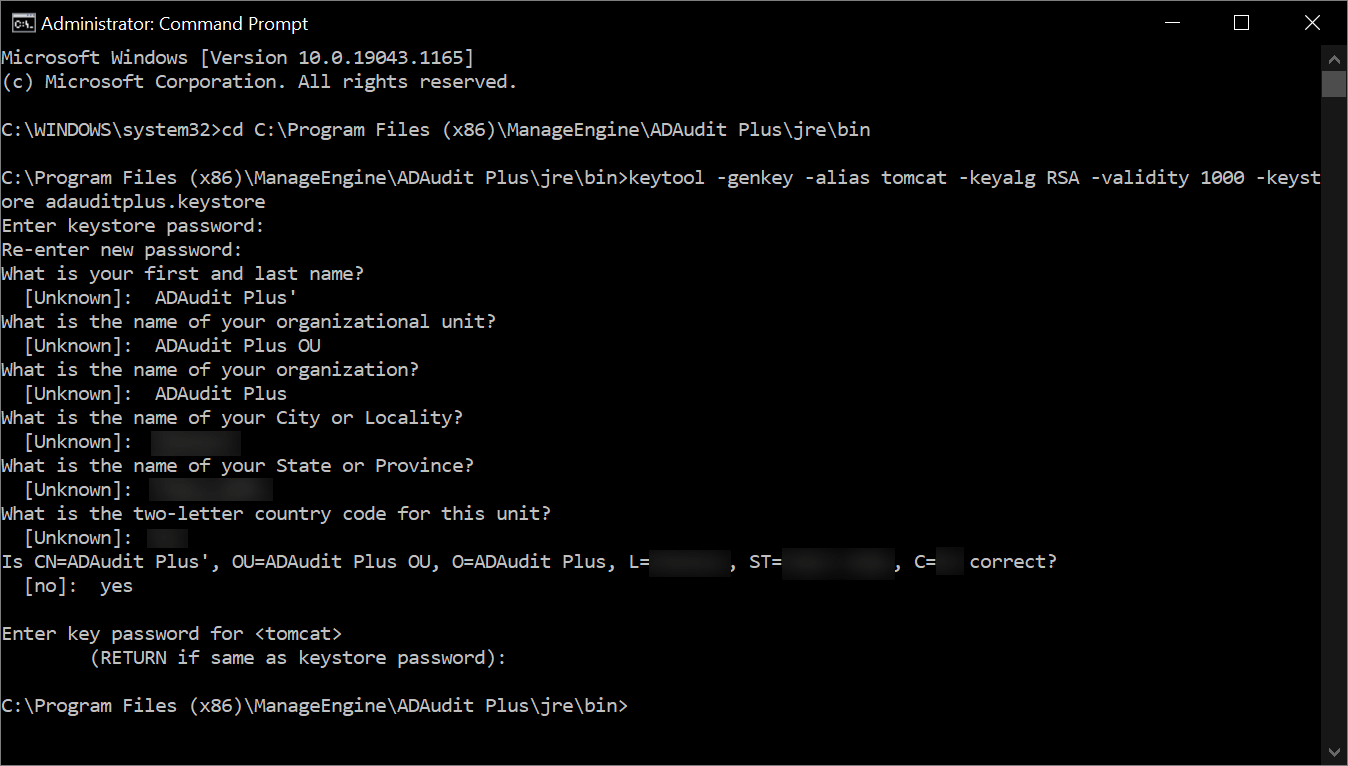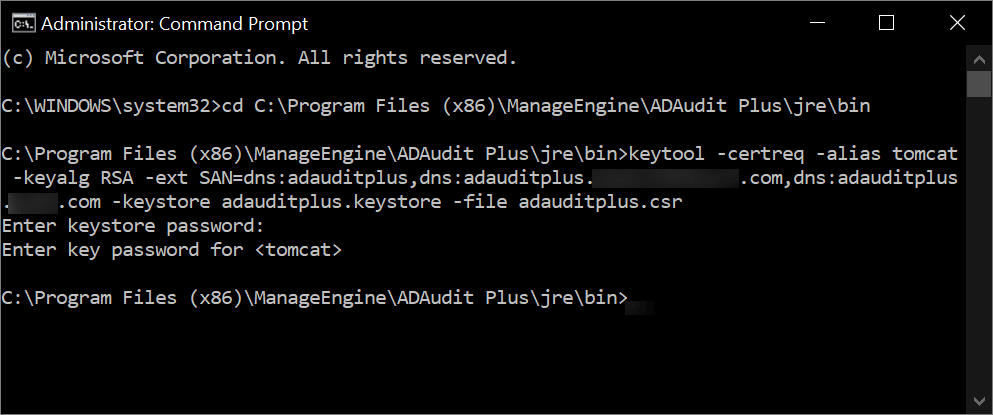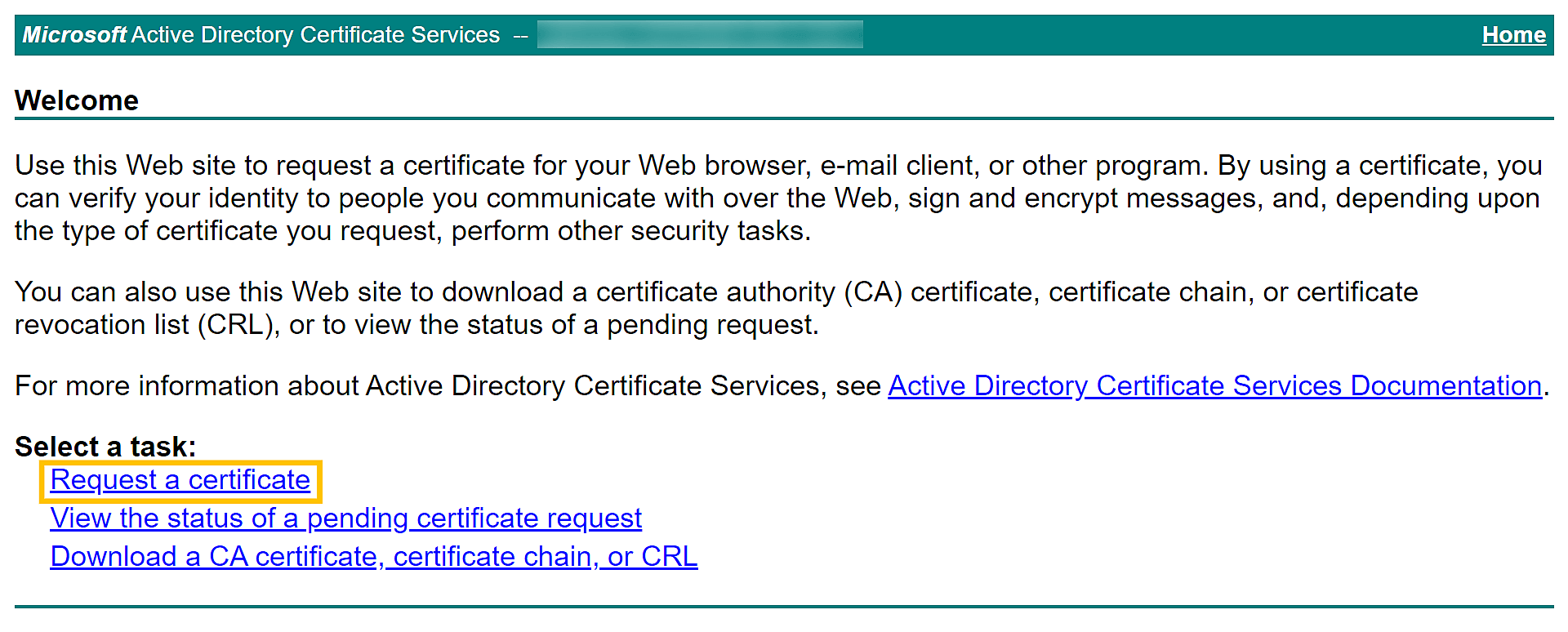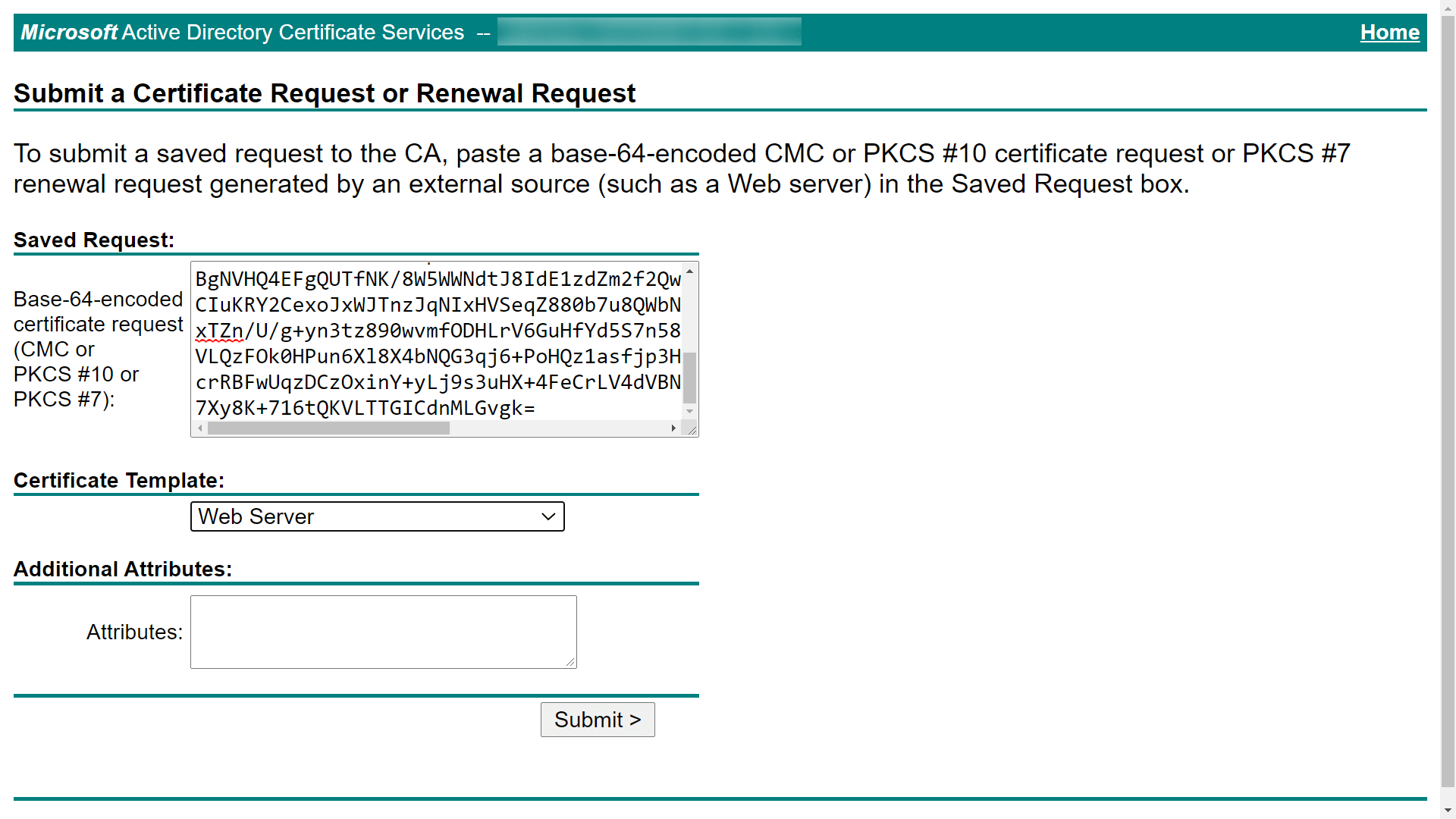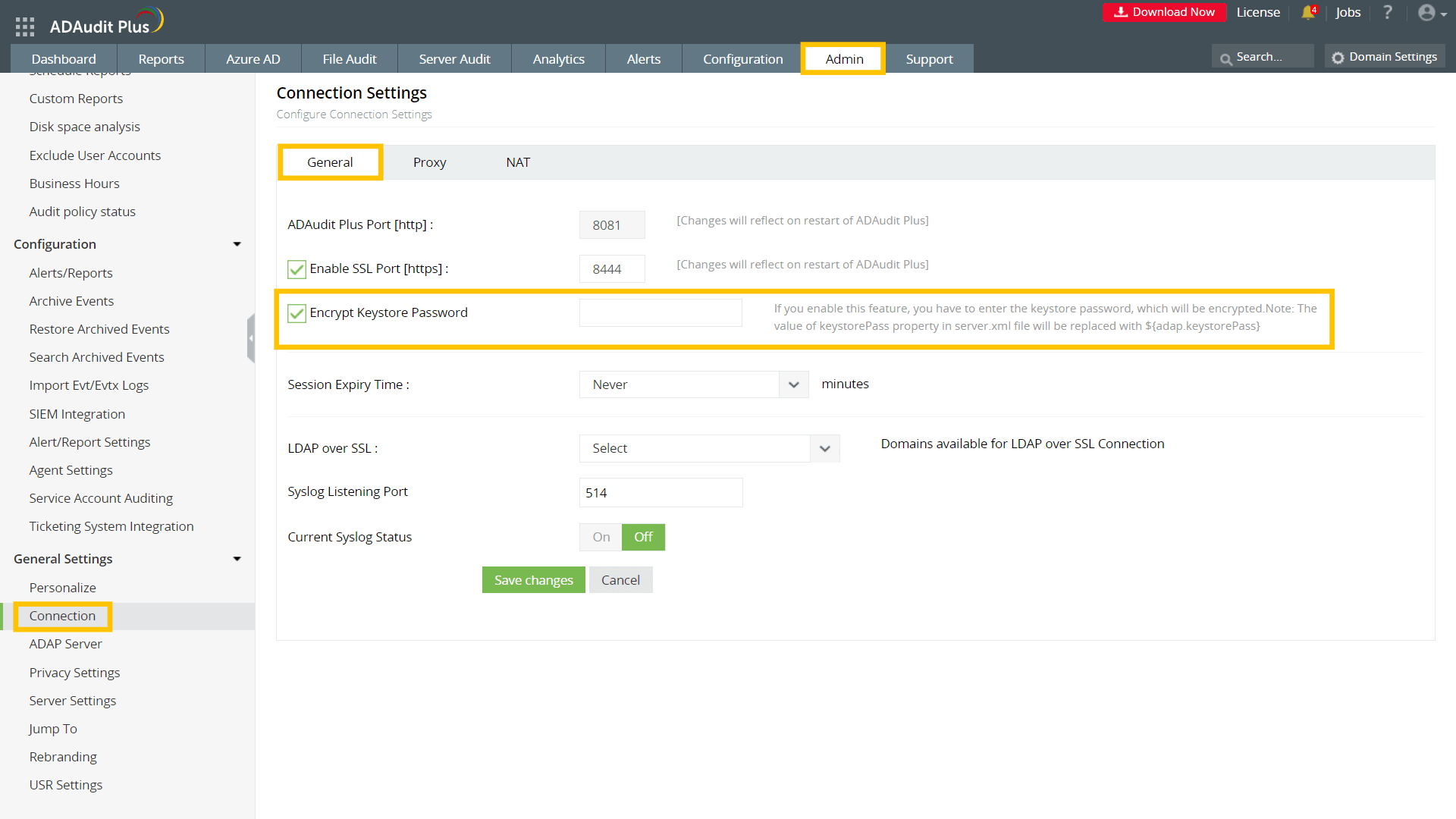|
The following steps will guide you through enabling SSL manually in ADAudit Plus. Step 1: Define the SSL portLog in to ADAudit Plus with an account that has administrative privileges. Navigate to Admin > General Settings > Connection. Check the Enable SSL Port [https] box. The default port number 8444 is selected automatically. Click Save changes. Restart ADAudit Plus for the changes to take effect. Note: If you want to install an existing PFX or PKCS #12 certificate, skip to the .
A keystore is a password-protected file that contains the keys and certificates for the server to encrypt and decrypt data. To create a certificate keystore file and generate encryption keys, run Command Prompt as an administrator, navigate to <product_installation_directory>\jre\bin, and execute the following command: keytool -genkey -alias tomcat -keyalg RSA -validity 1000 -keystore <domainName>.keystore Replace <domainName> with the name of your domain. Type in your keystore password. Provide information based on the following guidelines:
What is your first and last name?
Provide the machine name or the fully qualified domain name of the server hosting ADAudit Plus.
To create a CSR with a subject alternative name (SAN), execute the following command in Command Prompt: keytool -certreq -alias tomcat -keyalg RSA -ext SAN=dns:server_name,dns:server_name.domain.com,dns:server_name.domain1.com -keystore <domainName>.keystore -file <domainName>.csr Replace <domainName> with the name of your domain and provide the appropriate SANs as shown in the image below:
In this step, you will connect to a certificate authority (CA), submit the CSR to the specific CA, and get the SSL certificate issued to you. A. Issue the SSL certificate using an external CATo request a certificate from an external CA, submit the CSR to that CA. You can locate the CSR file in the <product_installation_directory>\jre\bin folder. Unzip the certificates returned by your CA and put them in the <product_installation_directory>\jre\bin folder. Note: After the SSL certificate is issued by the external CA, proceed to Step 5 to install the certificate. B. Issue the SSL certificate using an internal CAAn internal CA is a member server or domain controller in a specific domain that has been assigned the CA role. Connect to the Microsoft Active Directory Certificate Services of your internal CA and click the Request a certificate link.
On the Request a Certificate page, click the advanced certificate request link.
On the Submit a Certificate Request or Renewal Request page, copy the content from your CSR file and paste it in the Saved Request field. Select Web Server or the appropriate template for Tomcat under Certificate Template and click Submit.
The certificate will be issued when you click the Download certificate chain link. The downloaded certificate will be in the P7B file format.
Copy the P7B file to the <product_installation_directory>\jre\bin folder. Step 5: Import the certificateFollow the steps given below that correspond with the format in which you want to import the certificate. A. Privacy-enhanced mail (PEM) formatTo import the certificate into the keystore file in PEM format, open Command Prompt, navigate to <product_installation_directory>\jre\bin, and run the commands from the list below that applies to your CA. General commands keytool -importcert -alias root -file <root.cert.pem> -keystore <your.domain.com>.keystore -trustcacerts keytool -importcert -alias intermediate -file <intermediate.cert.pem> -keystore <your.domain.com>.keystore -trustcacerts keytool -importcert -alias intermediat2 -file <intermediat2.cert.pem> -keystore <your.domain.com>.keystore -trustcacerts keytool -importcert -alias tomcat -file <server.cert.pem> -keystore <your.domain.com>.keystore -trustcacerts Vendor-specific commands For GoDaddy certificates keytool -import -alias root -keystore <domainName>.keystore -trustcacerts -file gd_bundle.crt keytool -import -alias cross -keystore <domainName>.keystore -trustcacerts -file gd_cross.crt keytool -import -alias intermed -keystore <domainName>.keystore -trustcacerts -file gd_intermed.crt keytool -import -alias tomcat -keystore <domainName>.keystore -trustcacerts -file <domainName>.crt For Verisign certificates keytool -import -alias intermediateCA -keystore <domainName>.keystore -trustcacerts -file <your intermediate certificate.cer> keytool -import -alias tomcat -keystore <domainName>.keystore -trustcacerts -file <domainName>.cer For Comodo certificates keytool -import -trustcacerts -alias root -file AddTrustExternalCARoot.crt -keystore <domainName>.keystore keytool -import -trustcacerts -alias addtrust -file UTNAddTrustServerCA.crt -keystore <domainName>.keystore keytool -import -trustcacerts -alias ComodoUTNServer -file ComodoUTNServerCA.crt -keystore <domainName>.keystore keytool -import -trustcacerts -alias essentialSSL -file essentialSSLCA.crt -keystore <domainName>.keystore For Entrust certificates keytool -import -alias Entrust_L1C -keystore <keystore-name.keystore> -trustcacerts -file entrust_root.cer keytool -import -alias Entrust_2048_chain -keystore <keystore-name.keystore> - trustcacerts -file entrust_2048_ssl.cer keytool -import -alias -keystore <keystore-name.keystore> -trustcacerts -file <domainName.cer>/li> For certificates purchased through the Thawte reseller channel keytool -import -trustcacerts -alias thawteca -file <SSL_PrimaryCA.cer> -keystore <keystore-name.keystore> keytool -import -trustcacerts -alias thawtecasec -file <SSL_SecondaryCA.cer> - keystore <keystore-name.keystore> keytool -import -trustcacerts -alias tomcat -file <certificate-name.cer> -keystore <keystore-name.keystore> Once the certificate is installed, proceed to to bind the certificate to ADAudit Plus. Note: If you are receiving the certificates from a CA that is not listed above, then contact your CA to get the commands required to add its certificates to the keystore. B. P7B or PKCS #7 formatTo import the certificate into the keystore file in P7B or PKCS #7 format, open Command Prompt, navigate to <product_installation_directory>\jre\bin, and execute the following command: keytool -import -trustcacerts -alias tomcat -file certnew.p7b -keystore <keystore_name>.keystore Once the certificate is installed, proceed to to bind the certificate to ADAudit Plus. C. PFX or PKCS #12 formatCopy and save your PFX or PKCS #12 file in the <product_installation_directory>\conf folder. Open the server.xml file present in the <product_installation_directory>\conf folder with a local text editor. Create a backup of the existing server.xml file just in case you wish to restore it. Find the connector tag that contains <Connector ... SSLEnabled="true"... name="SSL".../>. Within the connector tag, make the following changes: Replace the value of keystoreFile with "./conf/<YOUR_CERT_FILE.pfx>". Add keystoreType="PKCS12". Save and close the server.xml file. <Connector SSLEnabled="true" URIEncoding="UTF-8" acceptCount="100" ciphers="TLS_ECDHE_RSA_WITH_AES_128_CBC_SHA256,TLS_ECDHE_RSA_WITH_AES_128_CBC_SHA,TLS_ECDHE_RSA_WITH_AES_256_CBC_SHA384,TLS_ECDHE_RSA_WITH_AES_256_CBC_SHA,TLS_RSA_WITH_AES_128_CBC_SHA256,TLS_RSA_WITH_AES_128_CBC_SHA,TLS_RSA_WITH_AES_256_CBC_SHA256,TLS_RSA_WITH_AES_256_CBC_SHA" clientAuth="false" connectionTimeout="20000" debug="0" disableUploadTimeout="true" enableLookups="false" keystoreFile="./conf/<YOUR_CERT_FILE.pfx>" keystorePass="*********" keystoreType="PKCS12"maxSpareThreads="75" maxThreads="150" minSpareThreads="25" name="SSL" port="8444" scheme="https" secure="true" sslEnabledProtocols="TLSv1,TLSv1.1,TLSv1.2" sslProtocol="TLS"/> Note: After modifying the server.xml file, skip to the "" section in Step 6. Step 6: Bind the certificates to ADAudit PlusCopy the <domainName>.keystore file from the <product_installation_directory>\jre\bin folder and paste it in the <product_installation_directory>\conf folder. Open the server.xml file present in the <product_installation_directory>\conf folder with a local text editor. Create a backup of the existing server.xml file just in case you wish to restore it. Find the connector tag that contains <Connector ... SSLEnabled="true"... name="SSL".../>. Within the connector tag, replace the value of keystoreFile with "./conf/<Your_Domain_Name>.keystore". <Connector SSLEnabled="true" URIEncoding="UTF-8" acceptCount="100" ciphers="TLS_ECDHE_RSA_WITH_AES_128_CBC_SHA256,TLS_ECDHE_RSA_WITH_AES_128_CBC_SHA,TLS_ECDHE_RSA_WITH_AES_256_CBC_SHA384,TLS_ECDHE_RSA_WITH_AES_256_CBC_SHA,TLS_RSA_WITH_AES_128_CBC_SHA256,TLS_RSA_WITH_AES_128_CBC_SHA,TLS_RSA_WITH_AES_256_CBC_SHA256,TLS_RSA_WITH_AES_256_CBC_SHA" clientAuth="false" connectionTimeout="20000" debug="0" disableUploadTimeout="true" enableLookups="false" keystoreFile="./conf/<Your_Domain_Name>.keystore" keystorePass="*********" maxSpareThreads="75" maxThreads="150" minSpareThreads="25" name="SSL" port="8444" scheme="https" secure="true" sslEnabledProtocols="TLSv1,TLSv1.1,TLSv1.2" sslProtocol="TLS"/> Save and close the server.xml file. Encrypt the keystore passwordLog in to your ADAudit Plus web console and navigate to Admin > General Settings > Connection. Select the General tab, check the Encrypt Keystore Password box, and enter the keystore password you used while generating the CSR for this certificate file. Click Save changes. Restart ADAudit Plus again for the changes to take effect. Note: If you want to modify the TLS versions and ciphers attribute, refer to our security hardening guide.
Don't see what you're looking for? (责任编辑:) |


